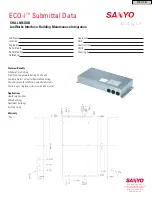
User manual LP dynamic processor
4
FILTERING AND SWITCHES
A "Mute" switch of the "HI" channels allows to temporarily cut the signal to the main
speakers.
The subwoofer channel offers the choice of two crossover transfer functions, a level control,
a subsonic protection and dynamic protection with the same three parameters control of the
loudspeakers.
The loudspeaker/subwoofer crossover is done with a 24dB/octave slope. The subwoofer
channel's upper crossover frequency is modified in accordance with the relative physical
placement of the subwoofers and the main speakers.
A switch allows choosing operation “with subs” or “without subs”.
Engaging the SUB switch introduces the necessary high-pass filtering of the main speakers.
The nominal cross-over frequency is comprised between 80 Hz and 110Hz depending on the
type of main speakers.
The subwoofer signal is either coming from the summation of left and right channels or from
an external signal (such as a dedicated auxiliary send)
DYNAMIC PROTECTIONS
The LP processor include three types of real-time active dynamic protections
-
Cone or diaphragm excursion: if the displacement exceeds the elastic capacity of the
suspension, the loudspeaker gets damaged, ending in its destruction. An excursion
amplitude detection system monitors the displacement and adjusts, if necessary, the cut-
off frequency of a sweeping high-pass filter, thus reducing the low frequency content of
the signal.
-
Voice coil temperature: excessive power increases the temperature of the moving coil,
which can eventually burn. A temperature detection simulator, based on the thermal
capacity of the voice coil, limits the amplitude of the signal in case of overheating.
-
Amplifier clipping: when reaching its limit (overload or clip), an amplifier loses its
capability to control the movement of the diaphragm, which then may get distorted or
collide with the polar pieces. Monitoring this limit is done in real time for any power rating
between 300 and 4000 W. As soon as the clipping threshold is detected, a limiter
reduces the amplitude of the signal.
-
The combination of these dynamic protections ensures the system is used reliably at the
maximum of its capability. These three protection types are based on real-time
simulations of the operational limiting parameters of loudspeakers and amps.
-
This process, contrary to a "sense return" type of control, can anticipate amplifier clipping
right at the processor, before any critical performance happens in the amplifier.
-
In addition, this allows using only one processor for a string of amplifiers receiving the
same signal.
-
Front-panel LED’s visualizing the operation of the various protection types, giving the
operator an indication of the safety margin of the system.
-
Occasional blinking of LED's on transients does not impact the acoustic response of the
system, it merely indicates nearing its limits
-
Permanent illumination of LED’s indicating the limits of the system are being exceeded
and damage may result if prolonged.




























